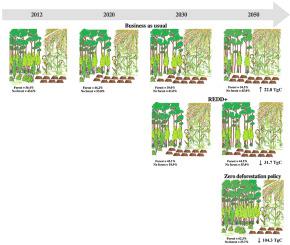Journal of Environmental Management ( IF 8.0 ) Pub Date : 2021-09-17 , DOI: 10.1016/j.jenvman.2021.113748 Alma Mendoza-Ponce 1 , Rogelio O Corona-Núñez 2 , Luzma Fabiola Nava 3 , Francisco Estrada 4 , Oscar Calderón-Bustamante 5 , Enrique Martínez-Meyer 6 , Julia Carabias 7 , Adriana H Larralde-Corona 8 , Mercedes Barrios 9 , Pedro D Pardo-Villegas 10

|
Land-use/cover change is the major cause of terrestrial ecosystem degradation. However, its impacts will be exacerbated due to climate change and population growth, driving agricultural expansion because of higher demand of food and lower agricultural yields in some tropical areas. International strategies aimed to mitigate impacts of climate change and land use-cover change are challenging in developing regions. This study aims to evaluate alternatives to minimize the impacts of these threats under socioeconomic trajectories, in one of the biologically richest regions in Guatemala and Mexico. This study is located at the Usumacinta watershed, a transboundary region that shares a common history, with similar biophysical properties and economic constraints which have led to large land use/cover changes. To understand the impacts on deforestation and carbon emissions of different land-management practices, we developed three scenarios (1): business as usual (BAU), (2) a reducing emissions scenario aimed to reduce deforestation and degradation (REDD+), and (3) zero-deforestation from 2030 onwards based on the international commitments. Our results suggest that by 2050, natural land cover might reduce 22.3 and 12.2% of its extent under the BAU and REDD + scenarios, respectively in comparison with 2012. However, the zero-deforestation scenario shows that by 2050, it would be possible to avoid losing 22.4% of the forested watershed (1.7 million ha) and recover 5.9% (0.4 million hectares) of it. In terms of carbon sequestration, REDD + projects can reduce the carbon losses in natural vegetation, but a zero-deforestation policy can double the carbon sequestration produced by REDD + projects only. This study shows that to reduce the pressures on ecosystems, particularly in regions highly marginalized with significant migration, it is necessary to implement transboundary land-management policies that also integrate poverty alleviation strategies.
中文翻译:

土地管理和气候变化对发展中和社会环境具有挑战性的跨界地区的影响
土地利用/覆盖变化是陆地生态系统退化的主要原因。然而,由于气候变化和人口增长,其影响将加剧,由于一些热带地区的粮食需求增加和农业产量下降,推动了农业扩张。旨在减轻气候变化和土地利用覆盖变化影响的国际战略在发展中地区面临挑战。本研究旨在评估替代方案,以在危地马拉和墨西哥生物最丰富的地区之一,将这些威胁在社会经济轨迹下的影响降至最低。本研究位于 Usumacinta 流域,这是一个具有共同历史的跨界区域,具有相似的生物物理特性和经济限制,导致土地利用/覆盖发生巨大变化。为了了解不同土地管理实践对森林砍伐和碳排放的影响,我们制定了三种情景 (1):一切照旧 (BAU),(2) 旨在减少森林砍伐和退化的减排情景 (REDD+),以及 ( 3) 根据国际承诺,从 2030 年起实现零森林砍伐。我们的结果表明,与 2012 年相比,到 2050 年,在 BAU 和 REDD+ 情景下,自然土地覆盖可能分别减少 22.3% 和 12.2%。然而,零毁林情景表明,到 2050 年,有可能避免失去 22.4% 的森林流域(170 万公顷)并恢复其中的 5.9%(40 万公顷)。在固碳方面,REDD+项目可以减少自然植被的碳损失,但零毁林政策只能使 REDD+ 项目产生的碳固存量增加一倍。这项研究表明,为了减轻生态系统的压力,特别是在移民数量众多的高度边缘化地区,有必要实施跨界土地管理政策,同时整合扶贫战略。











































 京公网安备 11010802027423号
京公网安备 11010802027423号